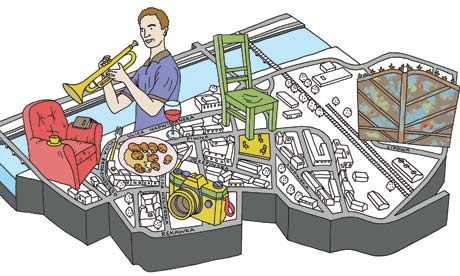
Before 2008, the last people of note to venture over the Vistula from central Krakow to Podgorze were Steven Spielberg's film crew. Auschwitz, 75km away, attracted all the tourists. The district of Podgorze, built by the ruling Habsburgs in the 19th century to rival the city centre across the water, was crumbling, grey and empty.
Spielberg set much of his 1993 film Schindler's List amid Podgorze's forgotten remnants: fragments of the ghetto wall, Tadeusz Pankiewicz's pharmacy, and the Schindler factory itself. The film brought Krakow to global attention. The old Jewish quarter of Kazimierz came back to life; then the bar hub around Plac Nowy became as busy as any in Prague or Budapest. Now, five minutes over the Pilsudski bridge by tram, Podgorze itself is where the scene is heading.
The new Qubus spa hotel - rooftop panoramic pool and all - stands beside the former Plac Zgody, where Nazis rounded up or massacred many from the adjoining Jewish ghetto. A young Roman Polanski was one of the few survivors. Today's Square of the Ghetto Victims features a permanent open-air installation dedicated to the victims. Nearby stand more new arrivals: an arty cafe, a chic Med-style restaurant, and probably the best bar in all Krakow - no idle boast these days. It is this bar, the Drukarnia, wantonly tatty and bohemian, whose recent relocation from the nightlife nexus of Kazimierz seals Podgorze's status as the new place to be. Filmmakers, musicians, students - everyone gravitates here.
By 2009, work will begin on the abandoned Forum Hotel down the river, developing a leisure stretch along the underused waterfront complete with a summer beach.
Cafe Rekawka
A recent addition to the Podgorze scene is this bohemian cafe with a literary feel. Armchairs sit beside a bookcase and vintage typewriter. Peruvian, Hawaiian and Indian coffees are served and sold loose, along with the more familiar Brazilian and Costa Rican varieties. Apple, carrot, spinach or walnut cakes may complement your cup of joe, along with salads, sandwiches and bruschettas. Kids are welcome - there are colouring books and pens.
• Ulica Brodzinskiego 4B (0048 12 196 2002).
Cava
This Mediterranean-themed bar and restaurant opened in September 2007. It's a breakfast-to-bedtime operation, the selection of salamis, cheeses and peppers good for snacking all day long. Snails are the signature dish, done in several styles, enjoyed by the young and well-heeled against a backdrop of Fashion TV and pastiche art. Cocktails, wines from southern Europe and, of course, cava, provide liquid sustenance.
• Ulica Nadwislanska 1 (+12 656 7456).
Drukarnia
With character in spades, the Drukarnia jazz bar is at the centre of Podgorze's recent revival. Just as popular as when it became a landmark destination in Kazimierz, the Drukarnia makes full use of its riverside location, with tables set outside offering the perfect view of sunset over the Vistula. Inside, a longer back bar has been added to cope with the overflow from the scuffed main room covered in black-and-white photographs of Krakow. Regular live jazz acts and DJs provide entertainment in the basement but banter, gossip and lively discussion over new artistic projects are the main pastime here.
• Ulica Nadwislanska 1 (+12 656 6560).
Plac Bohaterow Getta
Former Plac Zgody is the expansive main square set near the Vistula, criss-crossed by trams. Few tourists ventured this far until artists Piotr Lewicki and Kazimierz Latak opened a permanent installation of 70 chairs here in 2005. Nowy Plac Zgody - New Zgody Square - is a moving tribute to the thousands forced to abandon their worldly possessions before being marched to the nearby Plaszow work camp or sent to Auschwitz. At the back of the square, behind a map showing the ghetto landmarks of Podgorze, stands Tadeusz Pankiewicz's pharmacy, since converted into a museum. Principled, non-Jewish Pankiewicz helped many families for whom his business provided a place to meet and organise. Film, personal accounts and other documentation tell remarkable tales of bravery, luck and survival. Pankiewicz's account of the ghetto era provided the two artists with the idea for their installation.
• Pharmacy Museum: Plac Bohaterow Getta 18 (+12 656 5625).
Club Oko
Part art resource, part cafe, the Oko is the most prominent of several small local galleries springing up around Podgorze, attracting a young crowd. A permanent photographic exhibition of local scenes is the backdrop to an intimate interior where art workshops are regularly held. The building stands 100m from the house where Roman Polanski lived as a boy - although no one has thought to put up a plaque.
• Ulica Wegierska 1 (+12 423 5979, cluboko.pl).
Schindler factory
For most of the year, the original Schindler factory stands abandoned, the black bin bags over the windows a sorry tribute to the man who saved many Jewish lives by employing them during the Nazi occupation. Random exhibitions and concerts here can be memorable, though, most notably September's performances of music by Karlheinz Stockhausen, part of the city's Sacrum Profanum festival set in former industrial spaces. Even when locked, the gates attract a daily number of tourists on the Schindler trail. The future of the factory is still uncertain.
• Lipowa 4

